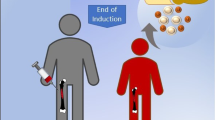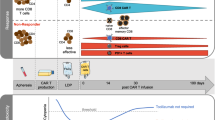Abstract
Cytokines are released during T cell activation, including the potentially anti-leukemic interferon-γ (IFNγ), but also the hematopoietic growth factor granulocyte-macrophage colony-stimulating factor (GM-CSF) that enhance proliferation and inhibit apoptosis of acute myelogenous leukemia (AML) cells. In the present study we investigated the release of IFNγ and GM-CSF by circulating T cells in AML patients with chemotherapy-induced cytopenia. T cells were activated with anti-CD3 plus anti-CD28 in a whole-blood assay in the presence of their natural cytokine network. We examined 63 samples derived from 16 AML patients during 28 chemotherapy cycles. Activated T cells showed a broad cytokine release profile, but IFNγ and GM-CSF levels showed a significant correlation and were generally higher than the other cytokine levels. Higher IFNγ and GM-CSF responses were associated with a low CD4:CD8 ratio, older patient age and no ongoing chemotherapy indicating potential utility of T cell activation regimes for the older AML patient. The cytokine levels could be further increased by the novel protein kinase C agonist PEP005, which also induced significant production of IL2 and TNFα which could contribute to anti-tumor effects in AML patients. We conclude that remaining T cells after intensive AML therapy show a broad cytokine release profile including high and significantly correlated levels of potentially anti-leukemic IFNγ and the AML growth factor GM-CSF. The final outcome of an AML-initiated T cell cytokine response will thus depend on the functional characteristics of the AML cells, in particular the relative expression of IFNγ and GM-CSF receptors which differs between AML patients.







Similar content being viewed by others
References
Behl D, Porrata LF, Markovic SN, Letendre L, Pruthi RK, Hook CC, Tefferi A, Elliot MA, Kaufmann SH, Mesa RA, Litzow MR (2006) Absolute lymphocyte count recovery after induction chemotherapy predicts superior survival in acute myelogenous leukemia. Leukemia 20:29–34
Beyne-Rauzy O, Recher C, Dastugue N, Demur C, Pottier G, Laurent G, Sabatier L, Mansat-De Mas V (2004) Tumor necrosis factor alpha induces senescence and chromosomal instability in human leukemic cells. Oncogene 23:7507–7516
Bruserud O (1999) Acute myelogenous leukemia blasts as accessory cells during T lymphocyte activation: possible implications for future therapeutic strategies. Leukemia 13:1175–1187
Bruserud O (1998) Cellular immune responses in acute leukaemia patients with severe chemotherapy-induced leucopenia; characterization of the cytokine repertoire of clonogenic T cells. Cancer Immunol Immunother 46:221–228
Bruserud O, Ulvestad E (2000) Acute myelogenous leukemia blasts as accessory cells during in vitro T lymphocyte activation. Cell Immunol 206:36–50
Bruserud O, Ulvestad E (2000) Cytokine responsiveness of mitogen-activated T cells derived from acute leukemia patients with chemotherapy-induced leukopenia. J Interferon Cytokine Res 20:947–954
Bruserud O, Ulvestad E, Berentsen S, Bergheim J, Nesthus I (1998) T-lymphocyte functions in acute leukaemia patients with severe chemotherapy-induced cytopenia: characterization of clonogenic T-cell proliferation. Scand J Immunol 47:54–62
Bruserud O, Wendelboe O (2001) Biological treatment in acute myelogenous leukaemia: how should T-cell targeting immunotherapy be combined with intensive chemotherapy? Expert Opin Biol Ther 1:1005–1016
Ersvaer E, Skavland J, Ulvestad E, Gjertsen BT, and Bruserud O (2006) Effects of interferon gamma on native human acute myelogenous leukaemia cells. Cancer Immunol Immunother
Foa R (1994) Interleukin-2 and gene therapy in the management of acute lymphoblastic leukaemia. Baillieres Clin Haematol 7:421–434
Hampson P, Chahal H, Khanim F, Hayden R, Mulder A, Assi LK, Bunce CM, Lord JM (2005) PEP005, a selective small-molecule activator of protein kinase C, has potent antileukemic activity mediated via the delta isoform of PKC. Blood 106:1362–1368
Harris NL, Jaffe ES, Diebold J, Flandrin G, Muller-Hermelink HK, Vardiman J, Lister TA, and Bloomfield CD (1999) The World Health Organization classification of neoplastic diseases of the hematopoietic and lymphoid tissues. Report of the Clinical Advisory Committee meeting, Airlie House, Virginia, November, 1997. Ann Oncol 10:1419–1432
Kedei N, Lundberg DJ, Toth A, Welburn P, Garfield SH, Blumberg PM (2004) Characterization of the interaction of ingenol 3-angelate with protein kinase C. Cancer Res 64:3243–3255
Komada Y, Zhang SL, Zhou YW, Hanada M, Shibata T, Azuma E, Sakurai M (1992) Cellular immunosuppression in children with acute lymphoblastic leukemia: effect of consolidation chemotherapy. Cancer Immunol Immunother 35:271–276
Kyle RA (2001) Update on the treatment of multiple myeloma. Oncologist 6:119–124
Kyrtsonis MC, Mouzaki A, Maniatis A (1999) Mechanisms of polyclonal hypogammaglobulinaemia in multiple myeloma (MM). Med Oncol 16:73–77
Mackall CL, Fleisher TA, Brown MR, Andrich MP, Chen CC, Feuerstein IM, Horowitz ME, Magrath IT, Shad AT, Steinberg SM et al (1995) Age, thymopoiesis, and CD4+ T-lymphocyte regeneration after intensive chemotherapy. N Engl J Med 332:143–149
Mackall CL, Fleisher TA, Brown MR, Andrich MP, Chen CC, Feuerstein IM, Magrath IT, Wexler LH, Dimitrov DS, Gress RE (1997) Distinctions between CD8+ and CD4+ T-cell regenerative pathways result in prolonged T-cell subset imbalance after intensive chemotherapy. Blood 89:3700–3707
Mackall CL, Fleisher TA, Brown MR, Magrath IT, Shad AT, Horowitz ME, Wexler LH, Adde MA, McClure LL, Gress RE (1994) Lymphocyte depletion during treatment with intensive chemotherapy for cancer. Blood 84:2221–2228
Ogbourne SM, Suhrbier A, Jones B, Cozzi SJ, Boyle GM, Morris M, McAlpine D, Johns J, Scott TM, Sutherland KP, Gardner JM, Le TT, Lenarczyk A, Aylward JH, Parsons PG (2004) Antitumor activity of 3-ingenyl angelate: plasma membrane and mitochondrial disruption and necrotic cell death. Cancer Res 64:2833–2839
Park HH, Kim M, Lee BH, Lim J, Kim Y, Lee EJ, Min WS, Kang CS, Kim WI, Shim SI, Han K (2006) Intracellular IL-4, IL-10, and IFN-gamma levels of leukemic cells and bone marrow T cells in acute leukemia. Ann Clin Lab Sci 36:7–15
Porrata LF, Litzow MR, Tefferi A, Letendre L, Kumar S, Geyer SM, Markovic SN (2002) Early lymphocyte recovery is a predictive factor for prolonged survival after autologous hematopoietic stem cell transplantation for acute myelogenous leukemia. Leukemia 16:1311–1318
Smith M, Barnett M, Bassan R, Gatta G, Tondini C, Kern W (2004) Adult acute myeloid leukaemia. Crit Rev Oncol Hematol 50:197–222
Vardiman JW, Harris NL, Brunning RD (2002) The World Health Organization (WHO) classification of the myeloid neoplasms. Blood 100:2292–2302
Wendelbo O, Bruserud O (2003) Functional evaluation of proliferative T cell responses in patients with severe T lymphopenia: characterization of optimal culture conditions and standardized activation signals for a simple whole blood assay. J Hematother Stem Cell Res 12:525–535
Wendelbo O, Nesthus I, Sjo M, Ernst P, Bruserud O (2004) Cellular immune responses in multiple myeloma patients with treatment-induced cytopenia early after high-dose chemotherapy and autologous peripheral blood stem cell transplantation. Leuk Res 28:461–468
Wendelbo O, Nesthus I, Sjo M, Paulsen K, Ernst P, Bruserud O (2004) Functional characterization of T lymphocytes derived from patients with acute myelogenous leukemia and chemotherapy-induced leukopenia. Cancer Immunol Immunother 53:740–747
Acknowledgments
The work was supported by the Norwegian Cancer Society and the European commission (LSHB-CT-2004–503467). The technical assistance of Kristin Paulsen and Aina Kvinnsland is gratefully acknowledged.
Author information
Authors and Affiliations
Corresponding author
Rights and permissions
About this article
Cite this article
Ersvær, E., Hampson, P., Hatfield, K. et al. T cells remaining after intensive chemotherapy for acute myelogenous leukemia show a broad cytokine release profile including high levels of interferon-γ that can be further increased by a novel protein kinase C agonist PEP005. Cancer Immunol Immunother 56, 913–925 (2007). https://doi.org/10.1007/s00262-006-0236-5
Received:
Accepted:
Published:
Issue Date:
DOI: https://doi.org/10.1007/s00262-006-0236-5




